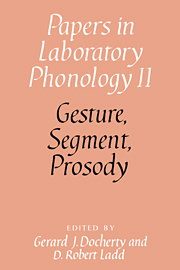Book contents
- Frontmatter
- Contents
- List of contributors
- Acknowledgments
- Introduction
- Section A Gesture
- Section B Segment
- 6 An introduction to feature geometry
- 7 The segment: primitive or derived?
- 8 Modeling assimilation in nonsegmental, rule-free synthesis
- 9 Lexical processing and phonological representation
- 10 The descriptive role of segments: evidence from assimilation
- 11 Psychology and the segment
- 12 Trading relations in the perception of stops and their implications for a phonological theory
- Section C Prosody
- Appendix 1 The test phrases (bold type) of experiment 1 in the context in which they were read
- Appendix 2 The distractors (bold type) of experiment 1 in the context in which they were read
- Appendix 3 The test sentences of experiment 2. The test words are in bold type
- Appendix 4 The distractor sentences of experiment 2. The distractors are in bold type
- References
- Name index
- Subject index
9 - Lexical processing and phonological representation
from Section B - Segment
Published online by Cambridge University Press: 18 December 2009
- Frontmatter
- Contents
- List of contributors
- Acknowledgments
- Introduction
- Section A Gesture
- Section B Segment
- 6 An introduction to feature geometry
- 7 The segment: primitive or derived?
- 8 Modeling assimilation in nonsegmental, rule-free synthesis
- 9 Lexical processing and phonological representation
- 10 The descriptive role of segments: evidence from assimilation
- 11 Psychology and the segment
- 12 Trading relations in the perception of stops and their implications for a phonological theory
- Section C Prosody
- Appendix 1 The test phrases (bold type) of experiment 1 in the context in which they were read
- Appendix 2 The distractors (bold type) of experiment 1 in the context in which they were read
- Appendix 3 The test sentences of experiment 2. The test words are in bold type
- Appendix 4 The distractor sentences of experiment 2. The distractors are in bold type
- References
- Name index
- Subject index
Summary
Introduction
In this paper, we are concerned with the mental representation of lexical items and the way in which the acoustic signal is mapped onto these representations during the process of recognition. We propose here a psycholinguistic model of these processes, integrating a theory of processing with a theory of representation. We take the cohort model of spoken word-recognition (Marslen-Wilson 1984, 1987) as the basis for our assumptions about the processing environment in which lexical processing takes place, and we take fundamental phonological assumptions about abstractness as the basis for our theory of representation. Specifically, we assume that the abstract properties that phonological theory assigns to underlying representations of lexical form correspond, in some significant way, to the listener's mental representations of lexical form in the “recognition lexicon,” and that these representations have direct consequences for the way in which the listener interprets the incoming acoustic–phonetic information, as the speech signal is mapped into the lexicon.
The paper is organized as follows. We first lay out our basic assumptions about the processing and representation of lexical form. We then turn to two experimental investigations of the resulting psycholinguistic model: the first involves the representation and the spreading of a melodic feature (the feature [nasal]); and the second concerns the representation of quantity, specifically geminate consonants. In each case we show that the listener's performance is best understood in terms of very abstract perceptual representations, rather than representations which simply reflect the surface forms of words in the language.
- Type
- Chapter
- Information
- Gesture, Segment, Prosody , pp. 229 - 260Publisher: Cambridge University PressPrint publication year: 1992
- 10
- Cited by



